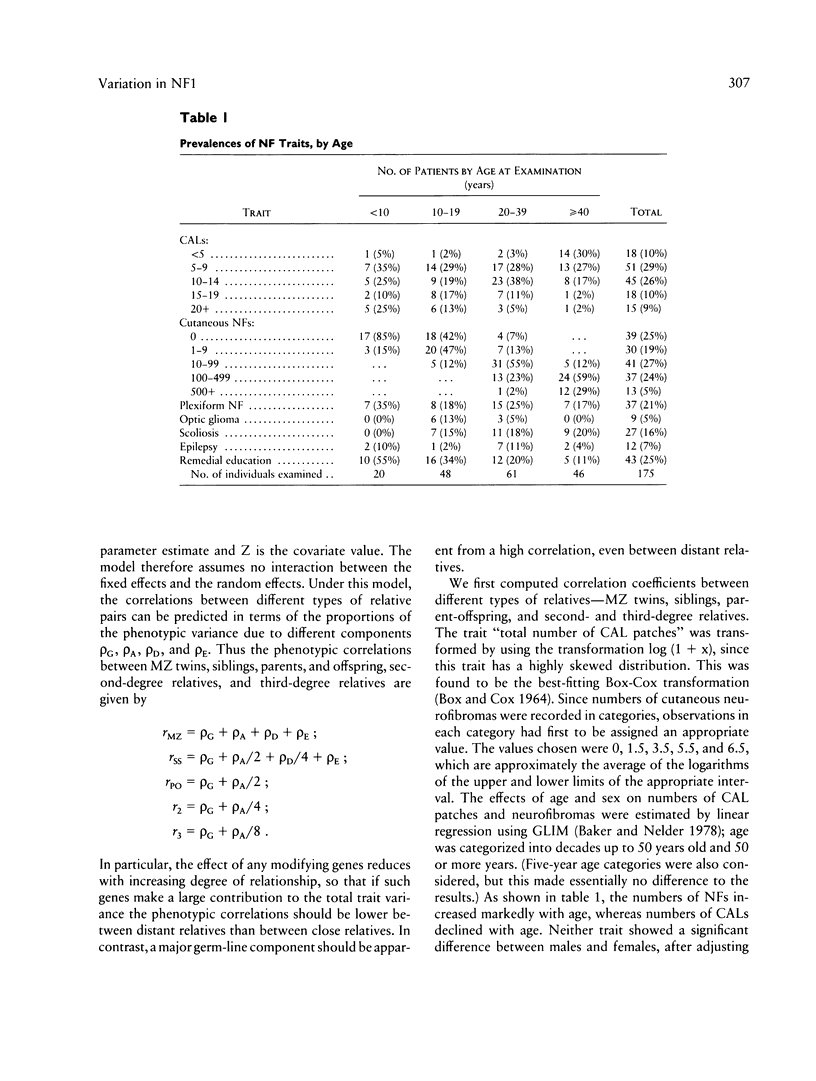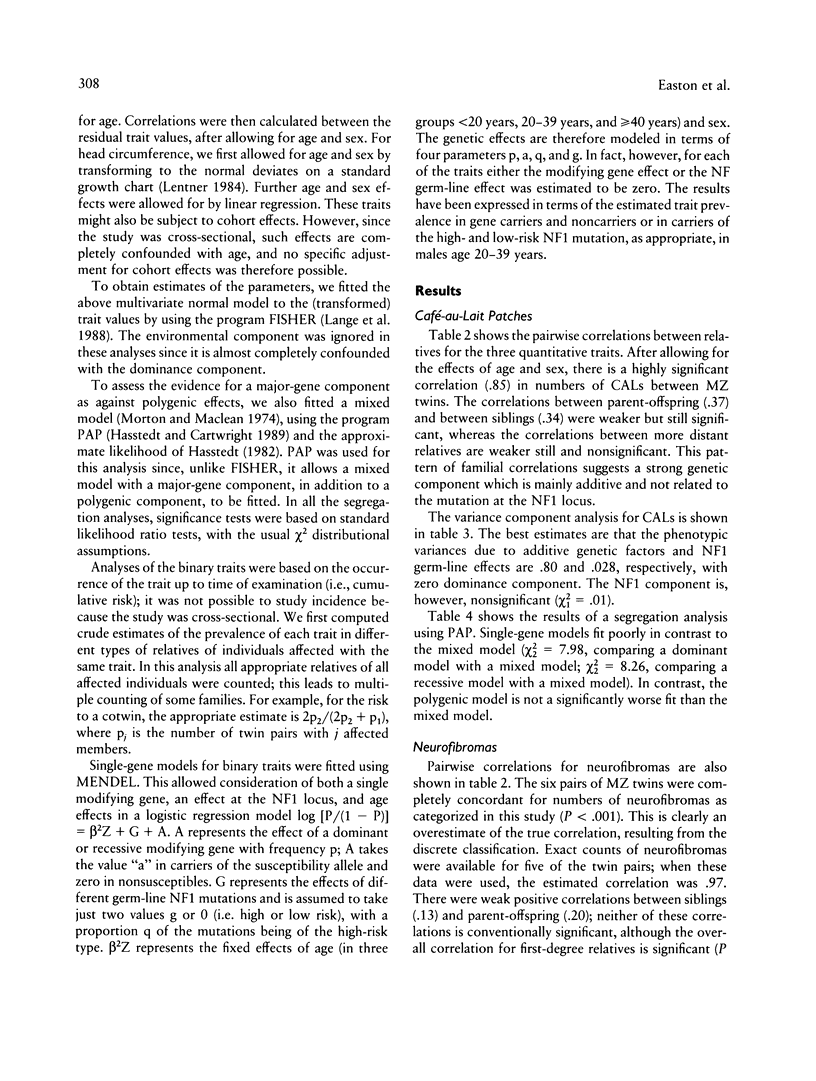Abstract
Neurofibromatosis (NF) type 1 (NF1) is notable for its variable expression. To determine whether variation in expression has an inherited component, we examined 175 individuals in 48 NF families, including six MZ twin pairs. Three quantitative traits were scored--number of café-au-lait patches, number of cutaneous neurofibromas, and head circumference; and five binary traits were scored--the presence or absence of plexiform neurofibromas, optic gliomas, scoliosis, epilepsy, and referral for remedial education. For café-au-lait patches and neurofibromas, correlation was highest between MZ twins, less high between first-degree relatives, and lower still between more distant relatives. The high correlation between MZ twins suggests a strong genetic component in variation of expression, but the low correlation between distant relatives suggests that the type of mutation at the NF1 locus itself plays only a minor role. All of the five binary traits, with the exception of plexiform neurofibromas, also showed significant familial clustering. The familial effects for these traits were consistent with polygenic effects, but there were insufficient data to rule out other models, including a significant effect of different NF1 mutations. There was no evidence of any association between the different traits in affected individuals. We conclude that the phenotypic expression of NF1 is to a large extent determined by the genotype at other "modifying" loci and that these modifying genes are trait specific.
Full text
PDF








Selected References
These references are in PubMed. This may not be the complete list of references from this article.
- Akesson H. O., Axelsson R., Samuelsson B. Neurofibromatosis in monozygotic twins: a case report. Acta Genet Med Gemellol (Roma) 1983;32(3-4):245–249. doi: 10.1017/s0001566000005109. [DOI] [PubMed] [Google Scholar]
- Atlas S. W., Zimmerman R. A., Bruce D., Schut L., Bilaniuk L. T., Hackney D. B., Goldberg H. I., Grossman R. I. Neurofibromatosis and agenesis of the corpus callosum in identical twins: MR diagnosis. AJNR Am J Neuroradiol. 1988 May-Jun;9(3):598–601. [PMC free article] [PubMed] [Google Scholar]
- BRADY W. J. Brain stem gliomas causing hydrocephalus in twins with von Recklinghausen's disease. J Neuropathol Exp Neurol. 1962 Oct;21:555–565. doi: 10.1097/00005072-196210000-00004. [DOI] [PubMed] [Google Scholar]
- Carey J. C., Laub J. M., Hall B. D. Penetrance and variability in neurofibromatosis: a genetic study of 60 families. Birth Defects Orig Artic Ser. 1979;15(5B):271–281. [PubMed] [Google Scholar]
- Crawford M. J., Buckler J. M. Optic gliomata affecting twins with neurofibromatosis. Dev Med Child Neurol. 1983 Jun;25(3):370–373. doi: 10.1111/j.1469-8749.1983.tb13774.x. [DOI] [PubMed] [Google Scholar]
- Diekmann L., Hüther W., Pfeiffer R. A. Ungewöhnliche Erscheinungsformen der Neurofibromatose (von Recklinghausensche Krankheit) IM Kindesalter. Abdominaltumor mit Klitorisvergrösserung. Renaler Hypertonus durch Nierenarterienstenose. Eineiige Zwillinge--Rankenneurome im Kopfbereich und Glaukom. Z Kinderheilkd. 1967;101(3):191–222. [PubMed] [Google Scholar]
- Hall J. G., Allanson J. E. Neurofibromatosis I: predicting the relation of gene structure to gene function. Am J Med Genet. 1991 Jan;38(1):135–135. doi: 10.1002/ajmg.1320380128. [DOI] [PubMed] [Google Scholar]
- Hasstedt S. J. A mixed-model likelihood approximation on large pedigrees. Comput Biomed Res. 1982 Jun;15(3):295–307. doi: 10.1016/0010-4809(82)90064-7. [DOI] [PubMed] [Google Scholar]
- Huson S. M., Compston D. A., Clark P., Harper P. S. A genetic study of von Recklinghausen neurofibromatosis in south east Wales. I. Prevalence, fitness, mutation rate, and effect of parental transmission on severity. J Med Genet. 1989 Nov;26(11):704–711. doi: 10.1136/jmg.26.11.704. [DOI] [PMC free article] [PubMed] [Google Scholar]
- Lange K., Weeks D., Boehnke M. Programs for Pedigree Analysis: MENDEL, FISHER, and dGENE. Genet Epidemiol. 1988;5(6):471–472. doi: 10.1002/gepi.1370050611. [DOI] [PubMed] [Google Scholar]
- Morton N. E., MacLean C. J. Analysis of family resemblance. 3. Complex segregation of quantitative traits. Am J Hum Genet. 1974 Jul;26(4):489–503. [PMC free article] [PubMed] [Google Scholar]
- Opitz J. M., Weaver D. D. The neurofibromatosis-Noonan syndrome. Am J Med Genet. 1985 Jul;21(3):477–490. doi: 10.1002/ajmg.1320210310. [DOI] [PubMed] [Google Scholar]
- Riccardi V. M., Kleiner B., Lubs M. L. Neurofibromatosis: variable expression is not intrinsic to the mutant gene. Birth Defects Orig Artic Ser. 1979;15(5B):283–289. [PubMed] [Google Scholar]
- Vaughn A. J., Bachman D., Sommer A. Neurofibromatosis in monozygotic twins: a case report of spontaneous mutation. Am J Med Genet. 1981;8(2):155–158. doi: 10.1002/ajmg.1320080205. [DOI] [PubMed] [Google Scholar]
- Wong Z., Wilson V., Patel I., Povey S., Jeffreys A. J. Characterization of a panel of highly variable minisatellites cloned from human DNA. Ann Hum Genet. 1987 Oct;51(Pt 4):269–288. doi: 10.1111/j.1469-1809.1987.tb01062.x. [DOI] [PubMed] [Google Scholar]


